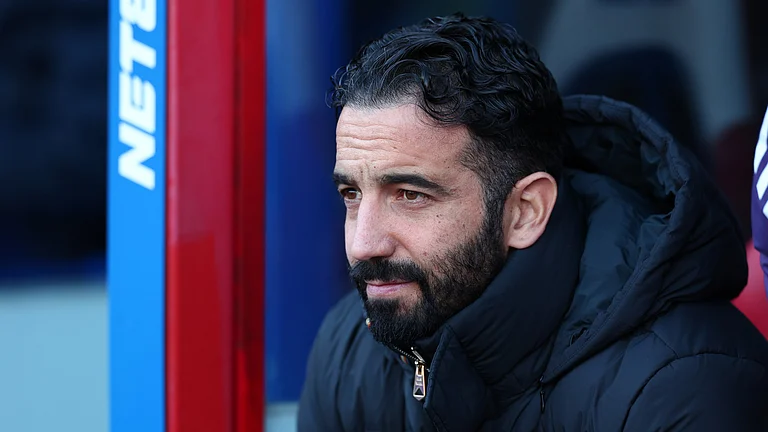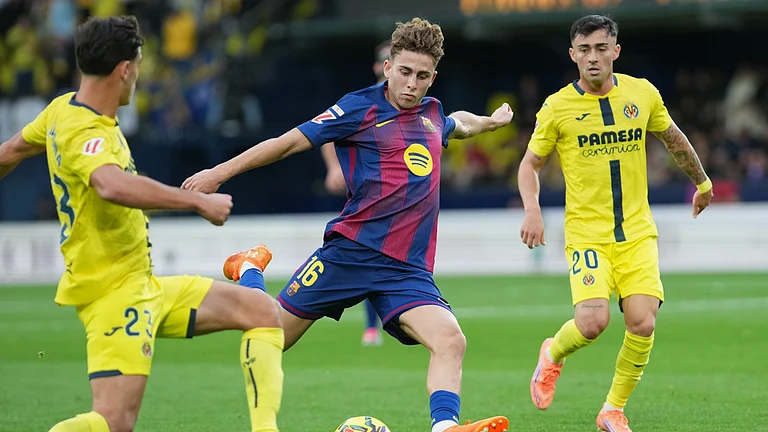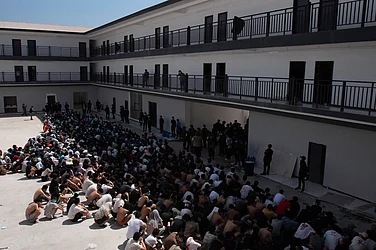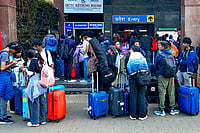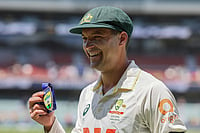Gupkar Road—the power avenue, home to Kashmir’s top politicians, rulers until a cold draught barrelled down from Delhi this August. It’s Friday, the day of the prayers. The entrance to the chinar-lined street is closed off with an iron barricade. An Intelligence Bureau (IB) official is in charge. Troopers of the paramilitary CRPF are assisting him. A shout away, Special Security Group (SSG) commandos stand in attention—a finger on the trigger of their automatics. A couple of J&K Police constables is there too—without their weapons, belts. Their job is to remove the barricade on the IB man’s instructions whenever he allows a vehicle to pass through. The official has strict instructions—no media on Gupkar Road.
What? Then who let those OB vans and cars of national TV news channels on the road, transmitting news live from the ground? The IB official smiles, directs the motley of print media reporters—mostly locals—towards the policemen who, in turn, point towards the SSG. A commando from the elite force looks up, scans the sky and almost yells: “Back off.” Instead, he says he has no information if media-people could be let in. The IB official relents after much persuasion.
The houses along Gupkar Road have been turned into ‘jails’—ahead of the Centre abolishing the special status to Jammu and Kashmir, and splitting the state into two Union territories on August 5. A few metres from the barricade, the SSG guards the single-storey bungalow of Dr Farooq Abdullah, former chief minister and son of the late Sheikh Abdullah. Reporters are not allowed inside. Reports say a police officer was suspended after a tearful Abdullah talked to NDTV on August 7. One of the officers tells Outlook that Abdullah has become restless as he seldom “stays at one place for a long time”.
His son, former chief minister Omar Abdullah, lives nearby. Two guards idle near the gate. Omar is, according to the government, in “preventive custody” since August 5 at Hari Niwas, the palace of Kashmir’s last king Hari Singh. Legend has it that the palace—a gift to Maharani Tara Devi against the king’s astrologer’s advice—is cursed. Soon after the queen entered the building, the tumult of 1947 forced the Dogra king to flee the Valley. It almost went waste over the years. The BSF used it as an interrogation centre in the early 1990s—a time when shrieks of tortured men pierced the hushed darkness. The CRPF occupied it later. In 2005, then chief minister Ghulam Nabi Azad ordered its renovation and turned it into the CM’s home in 2007. A year later, Azad lost his job.

A deserted Lal Chowk in Srinagar.
Ahead of Omar’s address is PDP leader Naeem Akhtar’s home. The party ideologue, close to the Muftis, defended the PDP-BJP alliance when the two were in power until last summer, describing it as the sole alternative for Kashmir. He often said if the arrangement failed, nothing would succeed in Kashmir. Guards declare Akhtar was not at home; he had been shifted to the Sher-i-Kashmir International Convention Centre (SKICC), along the boulevard abutting the Dal. Other mainstream politicians are also there— including Peoples Conference chairman Sajad Gani Lone, Imran Raza Ansari, Hakeem Yasin and Ali Mohammad Sagar.
Take a few more steps and CPI(M) state secretary M.Y. Taragami’s house pops up. The guards won’t speak about him, but whine about surviving on a ration of potatoes the past few days. The Fair View looms metres ahead; the home of former chief minister Mehbooba Mufti, who too is detained. Her daughter is said to be home, but can’t step out. From Fair View, Hari Niwas is just steps away. Mehbooba and Omar were at Hari Niwas initially, until Mufti Mohammad Saeed’s daughter was taken to tourism department’s Chesmashahi retreat where she is given a cottage.
There is no trace of the other top leaders. The government did not give any information about Waheed-ur-Rehman Parra, the PDP youth leader or the National Conference’s (NC) Tanveer Sadiq—both in custody, apparently. The NC and PDP offices—on Nawai Subh and Residency Road—are locked and paramilitary men guard them. Farooq Abdullah’s brother, Dr Mustafa Kamal, is also under house arrest on M.A. Road.
The arrests/detentions are not restricted to politicians. Officials, who don’t wish to be named, say nearly 650 people were picked up in Srinagar since August 4, some of them sent to jails outside the region, including Agra. At Ram Munshi Bagh police station on Friday, a woman pleads with the cops to free her 13-year-old son. He has been charged with trying to incite people to protest. How? Well, he tried to play a religious song on the loudspeaker of a mosque in Sonwar. “This is perhaps the second biggest arrest operation in Kashmir since 1990. It is unprecedented because both Abdullahs and Mehbooba Mufti have been arrested this time,” says a police officer.
At Lal Chowk on Sunday afternoon, a day before Eid, police announce on the tannoy that nobody should be staying outdoors—a reminder of the curfew. There aren’t many outside anyway. Troops had laid concertina wires on the roads. “You might have a curfew pass, but I will not entertain it. Tell the deputy commissioner I have refused to accept his pass,” a CRPF man told this reporter near Convent School Raj Bagh. On Eid (August 12), police vans fitted with microphones announce that no one must come out of their homes. They warn of dire consequences. Jamia Mosque was sealed and prayers were not allowed in the grand old mosque of Kashmir. Helicopter gunships hovered in the sky.
The number of soldiers in the Valley is the highest in decades—even for a region fighting 30 years of armed insurgency. A 70-year-old former president of a labour union recalls that the last time he saw these many troops was in August 1953 when then J&K PM Sheikh Abdullah was arrested in Gulmarg. “This time the betrayal is more shocking. That is why it took people many days to understand what has happened. This place will burn now,” he says.
“Kashmir Valley, particularly Srinagar, remained calm today,” government spokesman Rohit Kansal briefed the media ahead of Eid. The calm is worrying—a lull before the storm, perhaps. “This silence of the people is strange. I fear something serious is going to happen in the coming months and years,” a young army officer tells reporters. Like him, many Kashmiris harbour similar feelings. “I have never seen my father crying. I saw him in tears the day Article 370 was removed,” says a government employee.
The sadness is more for a large section of Kashmiris who believed in the Indian constitution, saluted the tricolour, and sang the national anthem. Another government official says it would take at least a year—or maybe more—for the people to fully understand the fallout of the decision to scrap Article 370 and Article 35A. “There is shock and disbelief. They think if Farooq Abdullah can be arrested, anyone in Kashmir can be put in jail,” he adds. People in Abdullah’s party, the National Conference, portend an apocalyptic catastrophe. When the anger subsides and remorse takes over, they lament in unison: “India, sadly, has pushed every Kashmiri towards Pakistan.” That sounds farfetched, but not so much at the SMHS hospital where a doctor points out a humanitarian crisis because of the “martial law-style” restrictions. “People might be dying in their homes. Who cares!”
By Naseer Ganai in Srinagar







